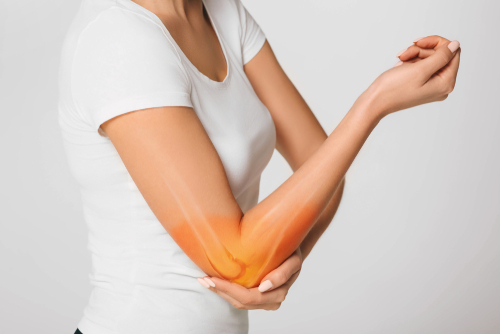
What is Meant by Bursitis?
Bursae are small fluid-filled sacs around the joints that cushion the bones, muscles and tendons. Inflammation of these bursae is referred to as bursitis and can be a painful condition that requires attention. Bursitis most commonly affects joints that require frequent movements such as the hip, shoulder, knee and elbow joints.
Types of Bursitis
Bursitis may occur over a period of time, meaning it can be chronic or can be a sudden occurrence, which is referred to as an acute complaint. Bursae are classified based on the site affected:
- Prepatellar or knee bursitis. Inflammation around the patella or the kneecap is known as prepatellar bursitis and can cause pain during movement. This results as a result of damage induced by activities such as staying on your knees for a long time, frequent bending at the knees, and other sports activities.
- Pes anserine bursitis. This is another bursa at the knee joint between the tibia (the shin bone) and the tendons that attach to the joint. Inflammation can lead to swelling and fluid accumulation around the knee. This is commonly seen among dancers as a result of repetitive rotatory movement of knees.
- Olecranon bursitis or elbow bursitis or student’s elbow. The olecranon process is located at the tip of your elbow. Inflammation of the bursae in this region is a common occurrence and can be felt as nodules in some people. This is most often due to resting your elbows on a hard surface for long periods of time such as your desk when in a classroom at work.
- Lateral malleolus bursitis. This occurs at the lateral side of the ankle and is a common finding among skaters and people who sit cross-legged for prolonged periods of time.
- Subacromial bursitis. Also referred to as shoulder bursitis, this occurs as a result of lifting heavy weights over the shoulders.
- Retrocalcaneal bursitis. This occurs in the heel leading to pain and swelling. Repetitive activities such as running, jumping, or wearing tight shoes that may cause friction at the heel can lead to retrocalcaneal bursitis.
- Trochanteric bursitis. Trochanteric bursitis is also known as hip bursitis. Other locations on the hip include the iliopectinal bursa. Lying on your hips for prolonged periods, improper posture while sitting and standing or medical conditions like arthritis can cause pain and swelling at the hip joint due to bursitis.
- Ischial bursitis. Also known as the weavers bottom, occurs at the buttocks as a consequence of sitting on a hard surface for long periods of time.
- Infectious or septic bursitis. This occurs as a result of a bacterial infection of the bursa that may enter through an open wound or happen as a result of a joint or blood infection. The symptoms are usually acute in onset and cause a lot of redness, pain and tenderness.
How Do You Know That Your Joint Pain is Because of Bursitis?
Bursitis is only one of the reasons for joint pain. Bursitis causes joint symptoms such as:
- Redness or swelling over the joint
- Tenderness, or pain upon pressing over the joint
- Achy or stiff joint with limited range of movement
- Sudden inability to move a joint
- Redness, pain associated with a fever, in the case of an infectious bursitis.
Though such symptoms give you a clue to the cause, it is important to rule out other conditions that can mimic bursitis, such as arthritis and tendinitis.
Difference Between Bursitis and Arthritis
An arthritis is due to wear and tear of the cartilage within joints, and is a permanent and progressive condition, unlike bursitis that is usually transient or short-lived. However, it is important to know that bursitis can also be seen as a result of arthritis due to long term irritation of the bursa as a result of worn-out cartilage or bony spurs within the joint.
Difference Between Bursitis and Tendinitis
Tendinitis occurs as a result of the inflammation of the tendon and not the bursa, due to overuse. Tendinitis is commonly seen among bowlers and pitchers and is referred to as a baseball pitcher’s arm when the tendon at the elbow is affected. It can be seen independently, or along with bursitis.
Causes of Bursitis
Bursitis can be the result of repeated actions at a joint, maintaining positions that put pressure on a joint for a long time, sudden injury, or infection. Activities that can trigger bursitis include:
- Gardening
- Painting
- Shovelling
- Scrubbing
- Dancing
- Sports like golf, tennis and baseball
Risk factors that can aggravate bursitis:
- Age: Your risk for developing bursitis increases as you age.
- Other medical conditions: People with diabetes, arthritis, thyroid disorders, obesity and gout are at a higher risk of developing bursitis, especially at the knee or hip.
- Activities and occupations that involve repetitive movements such as playing a musical instrument, laying tiles or painting may trigger bursitis.
When to See A Doctor? Treatment Options
Most people treat bursitis at home. However, it is essential to know when you should see a doctor:
- Pain lasting over two weeks.
- Pain that prevents movement at the joint in all directions.
- Fever associated with the joint inflammation
- Sharp shooting pains
- Excessive swelling or redness at the joint.
Such extreme conditions may require medical treatment under the advice of a treating physician such as a dose of steroids to reduce the inflammation or antibiotics in case of septic bursitis.
Long term effects of bursitis. Bursitis is usually a short-term condition that usually resolves with proper rest and treatment. However, if ignored or if the underlying condition is not treated, it can turn into a chronic condition causing long-term effects like restricted movement or painful motion at the joint.
At Narayana Health, joint and sports injury specialists are equipped to handle any complications or severity of bursitis. Do not hesitate to seek help and relieve your pain.
Prevention is Always Better
Preventing bursitis is possible in most cases by using protective gear or practicing proper posture while performing certain activities. Here are few ways to prevent bursitis:
- Use knee pads while performing activities that require kneeling for long periods of time.
- Proper stance while lifting heavy objects. Always bend your knee while lifting objects to prevent putting extra stress on the hip joint.
- Wheel heavy loads. Carrying heavyweight from one place to the other puts enormous stress on the shoulder joint and must be avoided when possible.
- Warm-up before exercising. Warming up and stretching before working out is a must to protect your joint from injury.
- Lifestyle modifications. Maintaining a healthy diet and weight helps to keep you fit and puts a lesser strain on your joints. This makes you less prone to injuries.


